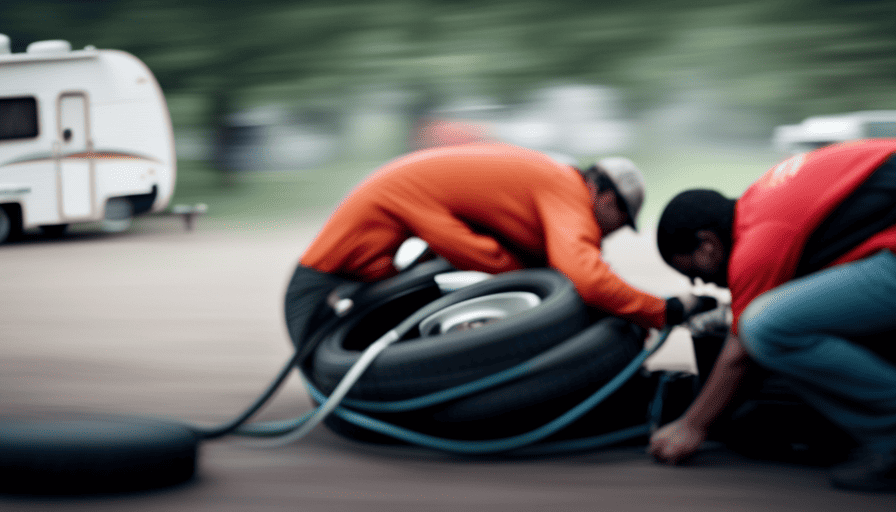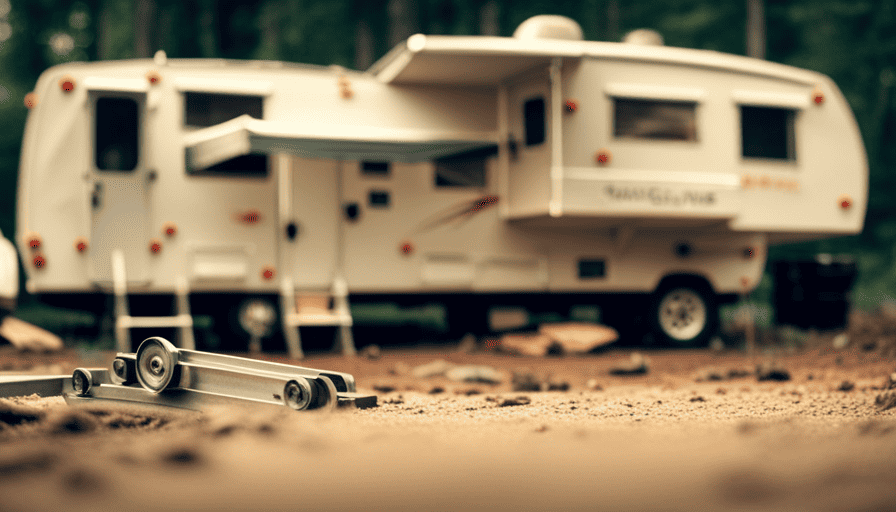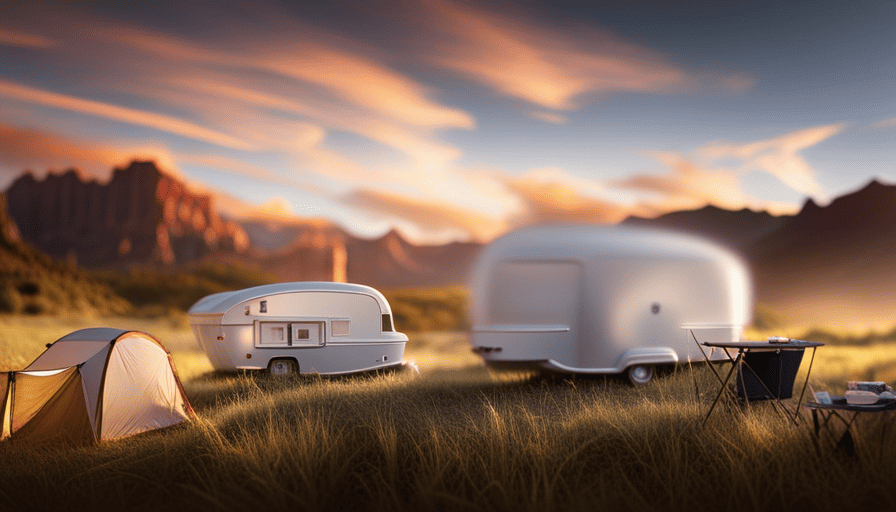Did you know that over 40 million Americans go on camping trips every year?
As the winter season comes to an end, it’s time to start preparing your camper for those upcoming outdoor adventures. Dewinterizing your camper is an important step to ensure that everything is in proper working order and ready for use.
In this article, I will guide you through the process of dewinterizing your camper, step by step. From removing any covers and inspecting the exterior, to checking and testing the battery, flushing and sanitizing the water system, and inspecting and cleaning the appliances, I will cover it all.
We will also discuss how to check the propane system, clean and organize the interior, and test the heating and cooling systems. Finally, we will do a test run and make any necessary adjustments to ensure that your camper is ready for your next camping trip.
So let’s get started and get your camper back in tip-top shape!
Key Takeaways
- Exterior inspection: Remove covers and inspect for damage or wear, check roof and seams for leaks or cracks, inspect exterior walls for water damage and proper sealing.
- Battery inspection and maintenance: Check and test battery for damage or corrosion, clean battery terminals and top up fluid levels if necessary, fully charge battery using a charger, test battery voltage with a multimeter.
- Water system maintenance: Flush and sanitize water system, drain tanks and fill with bleach solution, let solution sit for 12 hours, then flush with fresh water.
- Gas appliance maintenance: Inspect and clean gas appliances, check for leaks and clean burners and vents, clean refrigerator with mild dish soap and warm water.
Remove any Covers and Inspect the Exterior
Now it’s time for me to take off any protective covers and carefully inspect the exterior of my camper. I will make sure to pay attention to any signs of damage or wear that may have occurred during the winter months.
Inspecting the roof and seams is crucial to ensure that there aren’t any leaks or cracks that could lead to water damage. I’ll thoroughly examine the roof for any loose or missing shingles, as well as any signs of mold or mildew. Checking the seams for any signs of separation or deterioration is also important, as these areas are prone to leaks.
In addition, I’ll carefully inspect the exterior walls of my camper. I’ll look for any signs of water damage such as discoloration or soft spots. I’ll also check the windows and doors for proper sealing and make sure that they open and close smoothly. Any damaged or worn-out seals will need to be replaced to prevent water from entering the camper.
After inspecting the exterior, I’ll transition into the next section about checking and testing the battery.
Check and Test the Battery
First, picture yourself as a fearless adventurer embarking on a grand journey. As you prepare to dewinterize your camper, one crucial step is to check and test the battery.
Here are five important things to keep in mind for battery maintenance and charging:
- Inspect the battery for any signs of damage or corrosion.
- Clean the battery terminals using a mixture of baking soda and water to remove any buildup.
- Check the battery fluid levels and top up with distilled water if necessary.
- Use a battery charger to fully charge the battery before reconnecting it to the camper.
- Test the battery voltage using a multimeter to ensure it’s holding a charge.
By following these steps, you can ensure that your camper’s battery is in optimal condition for your upcoming adventures. With a fully charged and well-maintained battery, you can have peace of mind knowing that your camper’s electrical systems will function properly.
Now, let’s move on to the next section and learn how to flush and sanitize the water system.
Flush and Sanitize the Water System
As you embark on your grand adventure, it’s time to freshen up your water system by flushing and sanitizing it. This is an essential step in water system maintenance to ensure clean and safe water for your camping trips.
The flush and sanitize process involves removing any stagnant water and disinfecting the entire system.
To begin, drain all the water from your tanks, including the fresh water, gray water, and black water tanks. Make sure to open all faucets and drains to fully empty the system.
Next, mix a solution of water and bleach, using a ratio of 1/4 cup of bleach for every 15 gallons of water your system holds. Pour this solution into the fresh water tank and fill it up. Turn on all the faucets, including the shower, until you smell the bleach. Let it sit for at least 12 hours to kill any bacteria or contaminants.
After the waiting period, drain the bleach solution from the tanks and flush the system with fresh water. Run the faucets and drains until the bleach smell dissipates. This will ensure that the entire system is thoroughly rinsed.
Now, you are ready to move on to the next step of your camper’s maintenance – inspecting and cleaning the appliances.
By following these steps, you can maintain a clean and functional water system in your camper, ensuring a worry-free camping experience.
Inspect and Clean the Appliances
Once you’ve freshened up your water system, it’s time to give your appliances a thorough inspection and cleaning to ensure they’re in top-notch condition for your camping adventures.
Here are some important steps to follow:
-
Inspect Gas Appliances:
- Check the gas lines for any leaks or damage. Use a mixture of soap and water to test for leaks – if you see bubbles forming, there’s a leak.
- Clean the burners and vents of your stove or cooktop. Remove any debris or grease buildup that could affect their performance.
- Inspect the propane tanks for any signs of damage or rust. Ensure they’re securely attached and properly ventilated.
-
Clean Refrigerator:
- Remove all food items and shelves from the refrigerator.
- Mix a solution of mild dish soap and warm water, and use a sponge or cloth to wipe down the interior surfaces.
- Pay special attention to the door seals, as they can accumulate dirt and grime.
- Rinse thoroughly with clean water and dry with a soft cloth.
Once you’ve inspected and cleaned your appliances, it’s time to move on to the next step: checking and inflating the tires.
Check and Inflate the Tires
Next, it’s important to check and inflate the tires of your vehicle before heading out on your camping adventures. Proper tire maintenance is crucial for a safe and smooth journey.
Start by inspecting each tire for any signs of damage or wear, such as cracks, bulges, or punctures. If you notice any issues, it’s best to replace the tires before hitting the road.
Once you’ve inspected the tires, it’s time to check their inflation levels. Proper inflation is essential for optimal performance and safety. Underinflated tires can lead to poor fuel efficiency, decreased handling, and increased risk of a blowout. On the other hand, overinflated tires can result in a harsh ride and reduced traction.
To check the tire pressure, you’ll need a tire pressure gauge. Simply remove the valve cap from each tire and press the gauge onto the valve stem until you get a reading. Compare the reading to the recommended pressure indicated in your vehicle’s manual or on the tire sidewall. If the pressure is too low, use an air compressor to inflate the tires to the correct level.
Incorporating proper tire maintenance and ensuring the tires are inflated to the correct pressure will enhance your camping experience.
Once you’ve completed this step, it’s time to test the lights and electrical system for functionality and safety.
Test the Lights and Electrical System
Don’t forget to shed some light on your camping experience by testing the functionality and safety of your lights and electrical system. This step is crucial to ensure that you have a well-lit and comfortable environment during your camping trip. Here are some troubleshooting tips and common electrical issues to look out for.
Firstly, check all the exterior lights, including the headlights, taillights, brake lights, and turn signals. Make sure they’re all working properly and replace any burnt-out bulbs. Additionally, test the interior lights such as the ceiling lights, reading lights, and bathroom lights. If any of them aren’t functioning, check the fuses and replace them if necessary.
Next, inspect the electrical outlets inside the camper to ensure they’re in good condition and providing power. Plug in a small appliance or phone charger to confirm that they’re working correctly. If you encounter any issues, it could be due to a tripped circuit breaker or a faulty connection. Troubleshoot accordingly.
Common electrical issues in campers include blown fuses, loose connections, and faulty wiring. It’s important to address these problems promptly to prevent any safety hazards or inconvenience during your camping trip.
Now that you’ve tested the lights and electrical system, it’s time to move on to the next section and check the propane system. This’ll ensure that you have a reliable source of fuel for cooking and heating.
Check the Propane System
Make sure you take a moment to check the propane system, as it’s essential for a reliable fuel source for cooking and heating during your camping trip.
Here are some important steps for propane system maintenance and troubleshooting propane leaks:
-
Inspect the propane tanks: Check for any visible signs of damage or leaks. Look for rust, dents, or loose fittings. Ensure the tanks are securely fastened.
-
Check the regulator: The regulator controls the flow of propane from the tanks to the appliances. Make sure it’s properly connected and functioning correctly.
-
Test the propane appliances: Turn on each propane appliance one by one and make sure they’re working properly. Check for any unusual smells or sounds, as these could indicate a propane leak.
-
Look for propane leaks: Use a propane leak detector or a mixture of soap and water to check for leaks. Apply the solution to all connections and valves. If you see bubbles forming, it indicates a leak that needs to be addressed.
-
Ventilate the camper: Before using any propane appliances, open the windows and doors to allow fresh air circulation. This helps prevent a buildup of propane gas inside the camper.
After ensuring the propane system is in good condition, you can move on to the next section about cleaning and organizing the interior of the camper.
Clean and Organize the Interior
Once you’ve ensured the propane system is in good condition, it’s time to clean and organize the interior of your camper. Did you know that a clutter-free space can reduce stress and improve productivity by up to 40%? So, let’s get started on decluttering and creating efficient storage solutions in your camper.
First, take a look around and identify any items that you no longer need or use. Be ruthless in your decision-making process and only keep the essentials. Consider donating or selling items that are still in good condition but no longer serve a purpose for you.
Next, it’s time to find efficient storage solutions. Utilize the space under beds, benches, and inside cabinets by using storage bins or containers. These will help keep your belongings organized and easily accessible. Additionally, consider using collapsible or stackable containers to maximize space.
To further optimize your storage, use vertical space. Install hooks or racks on walls to hang items such as towels, jackets, or kitchen utensils. You can also use hanging organizers for shoes or toiletries.
Once you’ve decluttered and organized, you’ll have a clean and functional space to enjoy your camping experience. Now, let’s move on to the next step and test the heating and cooling systems to ensure your camper is ready for your next adventure.
Test the Heating and Cooling Systems
To ensure your camping experience is comfortable and enjoyable, it’s important to check the functionality of the heating and cooling systems in your camper. Before embarking on your next adventure, take the time to test the furnace and check the air conditioning.
Start by testing the furnace. Turn on the thermostat and set it to a higher temperature than the current one. Wait for a few minutes and listen for the sound of the furnace igniting. Feel the air coming out of the vents to ensure it’s warm and consistent. If the furnace fails to start or if the airflow is weak, there may be an issue that needs to be addressed before hitting the road.
Next, check the air conditioning. Turn on the AC unit and set it to a lower temperature. Listen for the sound of the compressor engaging and feel for cold air coming out of the vents. If the AC isn’t cooling properly or if there are any strange noises, it may be necessary to have it serviced or repaired before your trip.
Once you have tested the heating and cooling systems, you can move on to the next step of your camper dewinterization process. Make any necessary adjustments to ensure that your camper is ready for your upcoming camping adventures.
Do a Test Run and Make any Necessary Adjustments
After testing the heating and cooling systems, it’s time to move on to the next step of dewinterizing your camper. Now that you’ve ensured that the systems are functioning properly, it’s important to do a test run and make any necessary adjustments before hitting the road. This will help you identify any potential issues and give you peace of mind knowing that everything is in working order.
During the test run, pay close attention to the temperature settings and airflow. Make sure that the desired temperature is reached and that the air is evenly distributed throughout the camper. If you notice any inconsistencies or if the system doesn’t seem to be working as expected, it’s time to troubleshoot.
To help you troubleshoot any potential issues, I’ve created a table below that outlines common problems and possible solutions:
| Problem | Possible Solution |
|---|---|
| Uneven temperature distribution | Check for blocked vents or ducts. Clean or remove any obstructions. |
| System not cooling or heating enough | Check the thermostat settings and adjust if needed. Ensure that the system is not overloaded and that the filters are clean. |
| Strange noises or smells | Inspect the system for loose or damaged components. Clean or replace filters and check for any debris in the system. |
By following these troubleshooting tips and making necessary adjustments, you can ensure that your camper’s heating and cooling systems are in optimal condition for your upcoming adventures.
Frequently Asked Questions
How do I properly remove and store the winter covers for my camper?
To properly remove and store the winter covers for my camper, I follow a few steps. First, I carefully remove the covers, making sure not to damage them. Then, I clean and dry the covers thoroughly before folding them neatly.
I store them in a dry and secure location, such as a storage shed or garage, to protect them from any potential damage. Proper storage is essential to ensure the covers remain in good condition for future use.
What are some common signs of a faulty battery in a camper?
Signs of a faulty battery in a camper can include a slow cranking engine, dimming lights, or a battery that won’t hold a charge. If you notice these signs, it’s important to address the issue promptly.
Start by checking the battery connections for any corrosion or loose connections. If that doesn’t solve the problem, it may be time to replace the battery.
Regular maintenance and testing can help prevent battery issues and ensure a smooth camping experience.
What is the recommended method for flushing and sanitizing the water system in a camper?
To properly flush and sanitize the water system in a camper, there are a few recommended methods and techniques.
First, drain all the water from the system by opening the faucets and draining the water heater.
Then, mix a solution of water and RV-safe sanitizer, following the manufacturer’s instructions.
Next, run this solution through all the faucets, including the showerhead, toilet, and outside shower.
Lastly, thoroughly rinse the system by running clean water through all the faucets until the sanitizer smell is gone.
How often should I clean and inspect the appliances in my camper?
I clean and inspect the appliances in my camper regularly to ensure they’re in good working condition. The cleaning frequency depends on the specific appliance and its usage.
For example, I clean the refrigerator and stove every month, while the water heater and furnace are cleaned and inspected every six months. Regular maintenance prevents potential issues and extends the lifespan of the appliances, ensuring a smooth and enjoyable camping experience.
What steps should I take to ensure the propane system in my camper is functioning safely and efficiently?
Did you know that according to the National Fire Protection Association, propane-related incidents result in an average of 24,000 fires annually?
To ensure the safety and efficiency of your camper’s propane system, regular maintenance is crucial. Start by inspecting the propane tank for any signs of damage or leaks.
Then, troubleshoot the propane system by checking the pressure, regulator, and connections.
Remember, proper propane tank maintenance can prevent dangerous accidents and keep your camping experience worry-free.
Is Leveling Your Camper an Important Step in Dewinterizing It?
Leveling your camper is a crucial step during the dewinterization process. By ensuring that your camper is level, you prevent potential structural and mechanical issues. Uneven surfaces can strain the camper’s frame, affect appliances, and cause leaks. Leveling also helps with stability and comfort inside the camper, ensuring an enjoyable camping experience. So, make sure to prioritize leveling your camper before dewinterizing it.
Conclusion
In conclusion, dewinterizing your camper is like uncovering a hidden treasure, ready to be explored and enjoyed. By following these steps and taking the time to inspect, clean, and test every aspect of your camper, you can ensure a smooth and hassle-free camping experience.
Remember, just like a well-oiled machine, your camper needs a little TLC before hitting the road. So grab your checklist, roll up your sleeves, and get ready to embark on an adventure of a lifetime! Happy camping!










